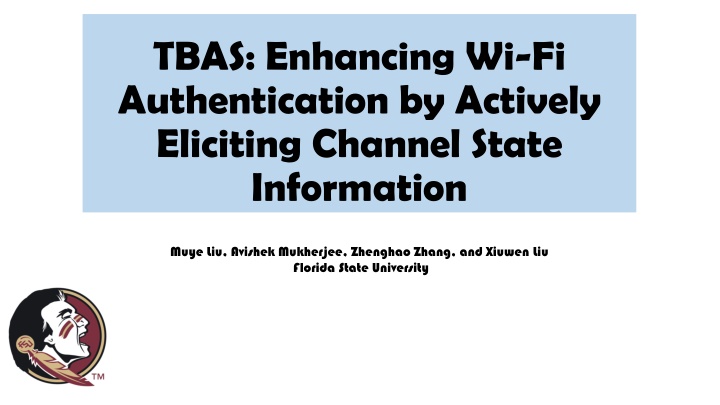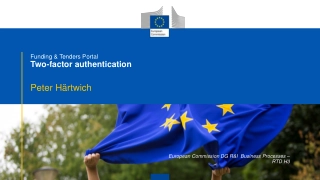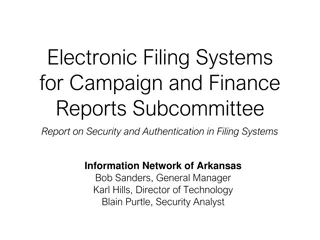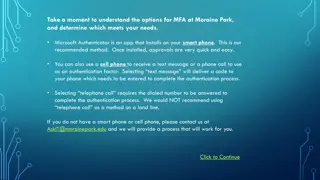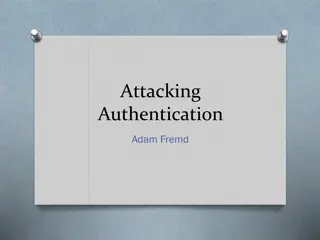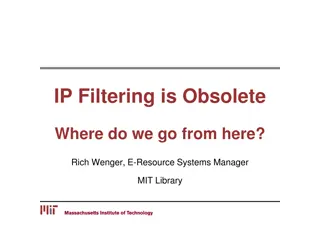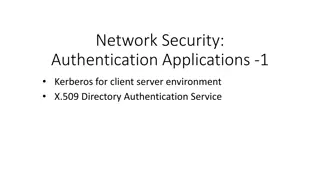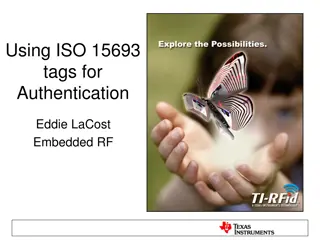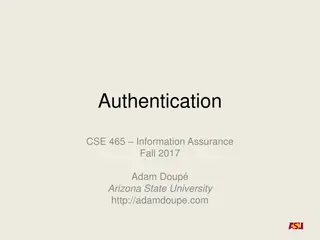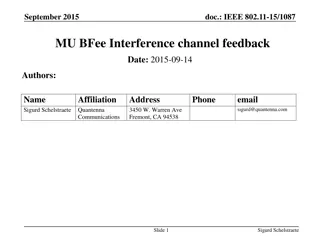Enhancing Wi-Fi Authentication Using Channel State Information
This research discusses enhancing Wi-Fi authentication by actively eliciting channel state information (CSI) to detect spoofing attacks. The challenge lies in obtaining the legitimate user's CSI and comparing it in real-time due to changing CSI and user traffic variations. The proposed approach involves actively eliciting CSI by sending probes to obtain responses from legitimate users, aiding in detecting spoofed identities and improving network security.
Download Presentation

Please find below an Image/Link to download the presentation.
The content on the website is provided AS IS for your information and personal use only. It may not be sold, licensed, or shared on other websites without obtaining consent from the author.If you encounter any issues during the download, it is possible that the publisher has removed the file from their server.
You are allowed to download the files provided on this website for personal or commercial use, subject to the condition that they are used lawfully. All files are the property of their respective owners.
The content on the website is provided AS IS for your information and personal use only. It may not be sold, licensed, or shared on other websites without obtaining consent from the author.
E N D
Presentation Transcript
TBAS: Enhancing Wi-Fi Authentication by Actively Eliciting Channel State Information Muye Liu, Avishek Mukherjee, Zhenghao Zhang, and Xiuwen Liu Florida State University
Motivation Spoofing in Wi-Fi: even a common laptop computer can be configured to send packets with faked identity Encryption-based protection cannot be relied upon in many cases users with weak passwords open networks such as some hotels and coffee shops A reliable method is needed to detect spoofing without password AP Hi, I am Bob! Alice Bob Muye Liu, Avishek Mukherjee, Zhenghao Zhang, and Xiuwen Liu Florida State University
Channel State Information (CSI) It has been proposed to use Channel State Information (CSI) to identify the user [yang2014] Muye Liu, Avishek Mukherjee, Zhenghao Zhang, and Xiuwen Liu Florida State University
Challenge in Using CSI for Authentication The challenge is to obtain the CSI of the legitimate user in time to for comparison The CSI may change If the new CSI is different from the ones in record, is it because the new CSI is from the attacker, or because the CSI changed? When the CSI is needed for comparison, the legitimate user may not be sending any packet depends on user traffic Muye Liu, Avishek Mukherjee, Zhenghao Zhang, and Xiuwen Liu Florida State University
Our Approach Not matching!!! Our key idea is to actively elicit the CSI: when the AP received a packet is received from Bob, it sends a probe (a small dummy packet), which will to elicit a response from Bob (the ACK) AP Hi, I am Bob! Alice s packet Alice Bob s packet Bob Muye Liu, Avishek Mukherjee, Zhenghao Zhang, and Xiuwen Liu Florida State University
What if Alice also sends a response? Not matching!!! The two responses will collide, the AP will not receive it and can also determine the previous packet is spoofed AP Hi, I am Bob! Alice s packet Alice Collision packet Bob Muye Liu, Avishek Mukherjee, Zhenghao Zhang, and Xiuwen Liu Florida State University
Key Advantages Key Advantages The Catch The Catch The CSI is collected when needed, and does not depend on user traffic Should achieve better performance Puts the attacker in a delimma No change to the Wi-Fi protocol, because a node will always send an ACK when it receives a packet Improving the security by only upgrading the AP, all user devices in the network can stay the same The additional overhead of probing However can be managed Muye Liu, Avishek Mukherjee, Zhenghao Zhang, and Xiuwen Liu Florida State University
Our Key Contributions The Channel State Check (CSC), which can tell if two packets are from the same sender based on the CSI A simple protocol to reduce the overhead of probing Muye Liu, Avishek Mukherjee, Zhenghao Zhang, and Xiuwen Liu Florida State University
Channel State Check (CSC) Problem: Given the CSI vectors from Packet 1 and Packet 2, are Packet 1 and 2 from the same sender? In our context Packet 1 and 2 are received within a short interval, e.g., a few milliseconds Packet 1 has been received correctly, Packet 2 may not Muye Liu, Avishek Mukherjee, Zhenghao Zhang, and Xiuwen Liu Florida State University
Channel State Check (CSC) Strawman Solution. Just subtract the two CSI vectors, and compare the squared error with a threshold Problem: The CSI of the legitimate user may change, difficult to select a good threshold value The threshold value should actually be determined by the time interval, the larger the interval, the more difference it should allow Muye Liu, Avishek Mukherjee, Zhenghao Zhang, and Xiuwen Liu Florida State University
Channel State Check (CSC) Therefore, the main idea of CSC is to calculate a check curve to be used as the expected CSI of Packet 2: not too far from the CSI in Packet 1 the distance determined by the time interval, allow some drifting best matches the measured CSI in Packet 2 If the CSI in Packet 2 is even far from check curve, something is wrong! Muye Liu, Avishek Mukherjee, Zhenghao Zhang, and Xiuwen Liu Florida State University
Channel State Check (CSC) Mathematically, it is to solve an optimization problem of finding a polynomial that : under the constraint that Muye Liu, Avishek Mukherjee, Zhenghao Zhang, and Xiuwen Liu Florida State University
Channel State Check (CSC) CSC does two checks: Noise level check: is the noise in Packet 1 and Packet 2 (by comparing with the check curve) similar? Residual correlation check: is the difference between CSI of Packet 2 and the check curve white noise? Muye Liu, Avishek Mukherjee, Zhenghao Zhang, and Xiuwen Liu Florida State University
Channel State Check (CSC) CSC does two checks: Noise level check: is the noise in Packet 1 and Packet 2 (by comparing with the check curve) similar? Residual correlation check: is the difference between CSI of Packet 2 and the check curve white noise? Muye Liu, Avishek Mukherjee, Zhenghao Zhang, and Xiuwen Liu Florida State University
Channel State Check (CSC) CSC does two checks: Noise level check: is the noise in Packet 1 and Packet 2 (by comparing with the check curve) similar? Residual correlation check: is the difference between CSI of Packet 2 and the check curve white noise? Muye Liu, Avishek Mukherjee, Zhenghao Zhang, and Xiuwen Liu Florida State University
Channel State Check (CSC) CSC performance on over 8000 packet pairs The need for two checks is clear Muye Liu, Avishek Mukherjee, Zhenghao Zhang, and Xiuwen Liu Florida State University
A Simple Protocol to Limit Overhead Simplest approach based on CSC: Every time a data packet is received 1. send a probe, get the CSI in the probe response 2. run CSC between the CSI in the data packet and the probe response, reject or accept the data packet depending on the decision of CSC Problem is high overhead Muye Liu, Avishek Mukherjee, Zhenghao Zhang, and Xiuwen Liu Florida State University
A Simple Protocol to Limit Overhead The main idea is to store the last accepted packet as history. When a new packet is received, 1. Run CSC between the new packet and the history 2. Depending on CSC: a. If passes, accepted the new packet, update history b. If fails, clear history, send probe, run CSC between the new packet and the probe response 3. Periodically clear the history Why it works in most cases when there is no attacker If the user has a high traffic, history is almost always fresh, and usually no need to send probe If the user has low traffic, sending a probe for each packet is fine Muye Liu, Avishek Mukherjee, Zhenghao Zhang, and Xiuwen Liu Florida State University
Evaluation We have verified the approach using Software-Defined Radio, achieving False Positive and False Negative ratios of around 0.1% Muye Liu, Avishek Mukherjee, Zhenghao Zhang, and Xiuwen Liu Florida State University
Evaluation Compared with a recent work Practical User Authentication Leveraging Channel State Information in ASIACCS 2014, referred to as SVM Muye Liu, Avishek Mukherjee, Zhenghao Zhang, and Xiuwen Liu Florida State University
False Positive Under various traffic load (HT, MT, or LT) transmission power (high or low) Channel mobility (stationary or mobile channel) Muye Liu, Avishek Mukherjee, Zhenghao Zhang, and Xiuwen Liu Florida State University
False Positive TBAS always has low FP ratios of around 0.001 or lower SVM sometimes has high FP ratio, like 0.1 Muye Liu, Avishek Mukherjee, Zhenghao Zhang, and Xiuwen Liu Florida State University
Overhead Measured by the fraction of time used by probe and probe response All around 0.001 or lower Muye Liu, Avishek Mukherjee, Zhenghao Zhang, and Xiuwen Liu Florida State University
False Positive with Delayed Response Configure the program to use the response of the next probe as that for this probe Longer delays between the data packet and the probe response, around 15 ms or more, testing TBAS under extreme conditions Still around 0.01 or lower, mobile channels affected more Muye Liu, Avishek Mukherjee, Zhenghao Zhang, and Xiuwen Liu Florida State University
False Negative Attacker sends the data packet, and has two strategies: Strategy 0: When a probe is received, do not respond Strategy 1: When a probe is received, respond Varying the transmission powers of the user and the attacker Muye Liu, Avishek Mukherjee, Zhenghao Zhang, and Xiuwen Liu Florida State University
False Negative TBAS has very low FN ratios, i.e., in the order 0.001 or below in all cases. SVM sometimes has higher FN ratios, such as around 0.26, in one of the cases. Muye Liu, Avishek Mukherjee, Zhenghao Zhang, and Xiuwen Liu Florida State University
Thank you! Muye Liu, Avishek Mukherjee, Zhenghao Zhang, and Xiuwen Liu Florida State University
